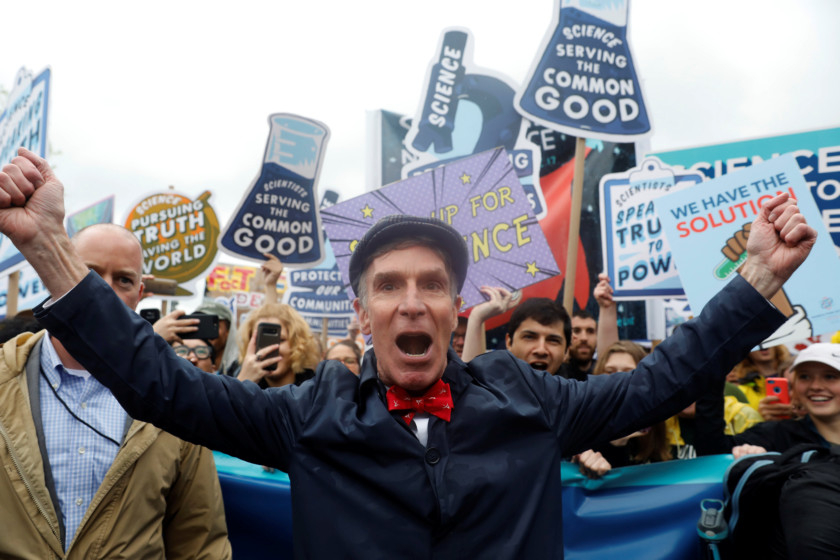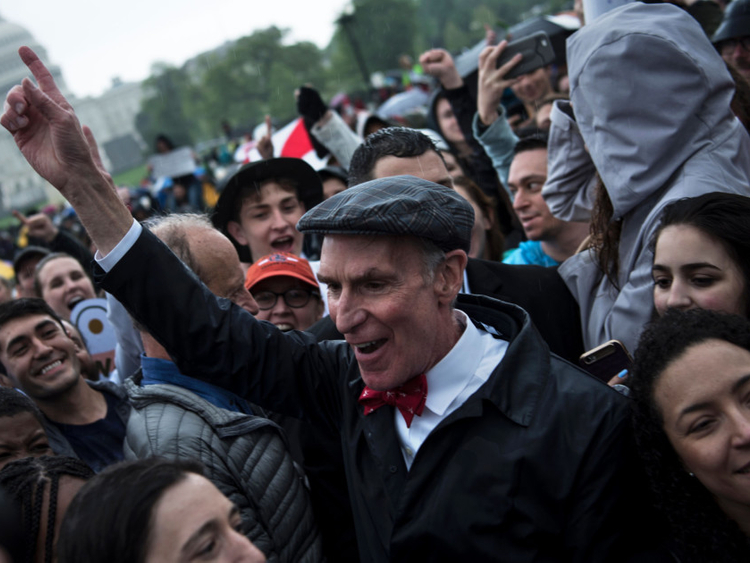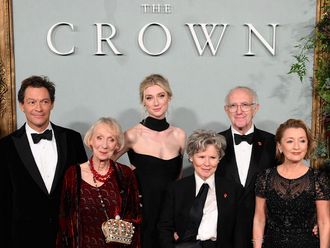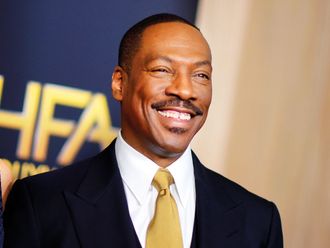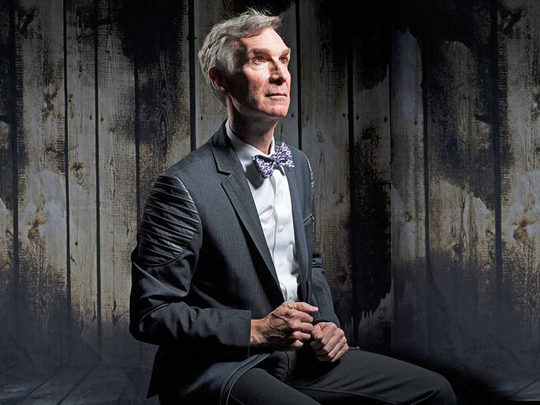
The moment he appeared on the stage in a black jacket and red bow tie, the crowd hit near-deafening decibels. A sea of iPhones appeared, everyone stretching and jostling for the best possible photo angle. They cupped their hands to their mouths, screaming his name.
“Greetings, fellow citizens,” Bill Nye said to the thousands huddled beneath umbrellas and hand-lettered signs. “We are marching today to remind people everywhere, our lawmakers especially, of the significance of science for our health and prosperity.”
Near the foot of the stage, a young woman with a bright green pixie cut shouted: “I love you!”
It was a significant moment — for science, for William Sanford Nye, and for the masses who have followed him for decades, from fuzzy TV screens in their middle school classrooms to the grounds of the Washington Monument at Saturday’s March for Science. He is beloved by millennials who came of age watching the ’90s-era PBS series Bill Nye the Science Guy, a role that made him an icon: half mad professor, half Mr. Rogers, perpetually clad in a pale blue lab coat and bow tie as he unveiled the science of eroding mountains or orbiting comets with theatrical flourish.
More than 20 years later, the 61-year-old still wears the bow ties, and he still punctuates his speech with impassioned catchphrases. (“It’s not magic, it’s science!” is his new favourite.) But now his dishevelled locks and vaguely Vulcan eyebrows are streaked with grey, and his persona has assumed a new edge. He’s become more than the zany educator-entertainer who charmed kids with cartoonish sound effects. He is an activist for science, leading those now-grownups into political battle.
Of all the roles he’s played, this is the one he was preparing for all along.
“I did imagine it could come to this,” Nye said Friday, during a visit to The Washington Post the day before the march.
By “this,” he meant the legions of scientists, doctors, engineers and concerned members of the public taking to the streets of Washington and more than 600 cities worldwide. Their demonstration was a response to the rise of anti-scientific notions — the anti-vaccination movement and climate change denial in particular — and a retort to the Trump administration, which has proposed deep budget cuts for the Environmental Protection Agency and the National Institutes of Health.
In the weeks before the march, many called this kind of mass protest from the scientific community unprecedented. But Nye was not surprised.
The current “anti-science thing,” he said, had been on the rise for decades. “People were denying pollution in 1970, saying it’s A-OK.”
He took note of the early warning signs as a young man in Seattle, where he got his start in broadcasting with a local sketch-comedy show. He was also volunteering on weekends at the Pacific Science Center and with the Big Brothers/Big Sisters program.
“I realised that kids are the future,” he said. “The reason I made the Science Guy show was quite deliberate. If we can get young people excited about science, then we have a shot. I knew I was fighting the fight.”
The fight is political, but not partisan, he emphasises. Still, he’s drawn his share of partisan critics. Some, like Sarah Palin, have questioned whether Nye is actually qualified to speak on behalf of science: “Bill Nye is as much a scientist as I am,” she once declared.
Nye chuckles in response: “Well, Ms. Palin, you’re wrong.”
To be fair: He did make his name as an entertainer. “I’m not a research scientist,” he acknowledged, like his good friend and fellow science celebrity Neil deGrasse Tyson, who climbed the academic ranks as an astrophysicist. Nye earned his bachelor’s in mechanical engineering at Cornell then went to work for Boeing. His fancier science credentials — designing an interplanetary sundial used by Nasa, and becoming CEO of The Planetary Society, a space advocacy group cofounded by Carl Sagan — came after his TV fame.
Still, his education was grounded in the scientific method. And, he argues, it doesn’t take a paleontologist to defend evolution, or a meteorologist to comprehend the perils of climate change.
“When you become scientifically literate, I claim, you become an environmentalist,” he said. “Somewhere along the way, there has developed this idea that if you believe something hard enough, it’s as true as things discovered through the process of science. And I will say that’s objectively wrong.”
And so, at a moment when science is at the forefront of public discussion, Nye has found himself in the spotlight once again — though in truth, he’s never quite left it. Since ‘Science Guy’ ended its five-year run in 1998, Nye has hosted other science education programs, sold out lecture halls and written best-selling books. He’s also racked up pop culture cred, with appearances on Dancing with the Stars, The Big Bang Theory and Inside Amy Schumer. He debuted a new 13-episode Netflix series on Friday, Bill Nye Saves the World, with a more urgent tone, and aimed at a broader audience, than his public TV days.
His fans include former President Barack Obama, who invited Nye to visit the Everglades with him on Earth Day 2015, and more than 4 million Twitter followers. But none are so devout as the twenty- and thirtysomethings who mob him everywhere he goes. (He happily obliges the selfie-seekers, always reminding them: “Look at the lens, not at yourself!”)
Nye isn’t married, and he never had children of his own — a neurological illness runs in his family, which “really affected my life choices,” he said. So he focused on other people’s children instead, determined to pass his own passion for science on to them. The little ones who watched his show became the young adults who would march beside him.
“The scope of it is really astonishing,” he said, with more awe than swagger. “There are millions of kids who watched the show. I’m very proud of that.” He smiled slightly. “But I don’t think I quite get it.”
But then it’s the day of the march, and he’s in a white van driving him and the other event leaders to the starting point, and the streets are lined with signs that say “Science, not Silence” and “Facts Matter,” and maybe he’s starting to get it a little bit more.
“Look! This is so, so freaking cool,” he says, pointing out the window.
“Look at all the people,” he says when he steps outside, and again when he takes his place behind the big “March for Science” banner and starts shuffling down Constitution Avenue beneath a steady rain.
“Can I get a picture? I became a scientist because of you,” a young woman asks him, and Nye puts his arm over her shoulders.
It ends just before 3pm in front of the Capitol, where the massive crowd gathers around Nye and his fellow co-chairs for one last group photo.
“Can we get a thank you for Bill Nye?” one man bellows, and another adds: “Bill Nye, you’re the voice of a generation!”
The chant starts up again: “Bill! Bill! Bill!”
Nye bows his head slightly, then raises his hand into the air, three fingers outstretched. It’s the motion of a teacher trying to quiet a classroom, reminding his students to focus — not on him, but on what he taught them. He counts down: “Three, two, one!”
And they answer in heartfelt unison: “SCIENCE!”
Don’t miss it
Bill Nye Saves the World is now streaming on Netflix.



